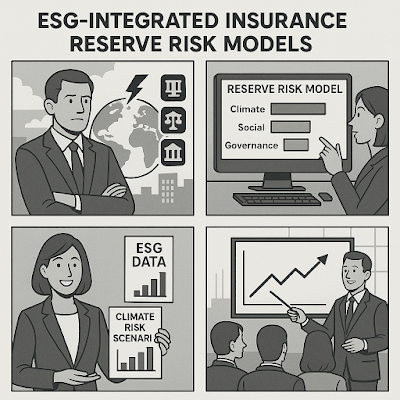How to Build ESG-Integrated Insurance Reserve Risk Models
How to Build ESG-Integrated Insurance Reserve Risk Models
As the insurance industry navigates a future shaped by climate volatility, social disruption, and regulatory evolution, traditional actuarial models are proving insufficient.
Reserving risk no longer depends solely on loss frequency and historical claims—today, it must integrate ESG indicators that reflect emerging liabilities, shifting demographics, and evolving climate patterns.
This is why ESG-integrated insurance reserve risk models are gaining traction across insurers, reinsurers, and regulatory bodies alike.
These models incorporate non-financial data into the actuarial core to improve capital adequacy, pricing stability, and solvency foresight.
📌 Table of Contents
- Why ESG Integration Is Critical in Reserving
- Core Components of ESG Reserve Models
- Data Sources and Scoring Frameworks
- Technology Stack and Modeling Techniques
- External Tools and Relevant Use Cases
🌍 Why ESG Integration Is Critical in Reserving
Catastrophic weather events, demographic shifts, governance failures, and litigation trends are now material risk factors for insurers.
Ignoring these ESG signals can result in under-reserving, mispricing, and regulatory non-compliance.
Integrated models help insurers anticipate future liabilities more accurately and align with frameworks like Solvency II, IFRS 17, and ICS.
📐 Core Components of ESG Reserve Models
• **Climate Exposure Layers** – Risk weighting based on geographic and sectoral climate vulnerability (e.g., flood-prone assets).
• **Social Instability Index** – Factors such as civil unrest trends, aging populations, and healthcare burden.
• **Governance Maturity Scores** – Assessment of claims governance, transparency, and data control systems.
• **Stress Test Integration** – Model includes dynamic climate and ESG stress scenarios for adverse reserving outcomes.
📊 Data Sources and Scoring Frameworks
• **TCFD & NGFS** – Climate risk scenarios and macroeconomic linkages
• **WHO & OECD** – Public health and demographic change forecasts
• **World Bank & UN PRI** – Governance and stakeholder metrics
• **Sustainalytics & MSCI** – ESG ratings to enrich actuarial input variables
🧠 Technology Stack and Modeling Techniques
• **Generalized Linear Models (GLMs)** with ESG feature inputs
• **Bayesian Forecasting** to handle uncertainty in ESG scenarios
• **Python, R, and SAS** for data pipeline integration and stress test simulations
• **Visualization Dashboards** (Tableau, Power BI) for executive and regulatory communication
🔗 External Tools and Relevant Use Cases
Ensure fairness and transparency in AI-powered reserving models.
Build resilient, compliant data pipelines across jurisdictions for insurance models.
Incorporate ESG engagement patterns into reserving and investment modeling.
Keywords: ESG insurance modeling, actuarial reserve risk, climate-adjusted underwriting, ESG data in insurance, compliance forecasting
